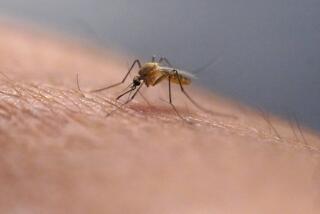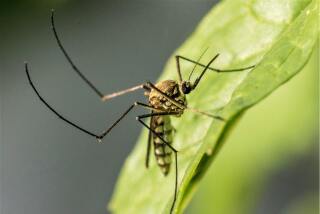Mosquito Alert
Orange County officials report a 54% increase in complaints by residents who say mosquitoes are appearing in greater numbers around their houses and generally causing problems--like biting the adults and children who live there.
“We just do our best to control them, and we’re right on top of it, but most people don’t think there’s any problem with mosquitoes--unless they get bit, and bit a lot, and then there’s a big problem,” said Jim Francisco, educational coordinator for the Orange County Vector Control District.
Francisco said that vector control officials recorded 7,023 “service requests,” or complaints, involving mosquitoes during 1996.
From January through July of this year, however, the agency recorded 7,712 requests, well ahead of all of last year. And comparing the number of calls to Aug. 1 each year shows a 54% increase in 1997.
Still, nobody seems worried.
“It didn’t startle us; it surprised us,” he said. “We don’t believe there’s a crisis, or a problem, and a lot of the increase may be due to public awareness. But we have seen an increase.”
Another reason might be rainfall. Mosquitoes thrive in rain, the experts say, and through Monday, rainfall in Orange County was already more than two inches greater than rainfall during all of 1996.
“We recorded 11.33 inches of rain last year,” said Mel Newman, environmental resources specialist for Orange County, “and so far this year, we’ve had 13.53 inches of rain.”
For some reason, the mosquito figures appear to be proportionately higher in Orange County than Los Angeles County, and San Diego reports little change.
Los Angeles County has six separate vector control districts, but the largest, headquartered in Santa Fe Springs, reports an increase similar to that of Orange County: 899 complaints involving mosquitoes so far this year, compared with 765 all of last year. Officials there say the other five districts reported similar increases.
Moise Mizrahi, spokesman for the San Diego County Vector Control District, reports that mosquito activity in his area is “almost exactly the same” this year as compared to last, which wasn’t a bad year.
Officials often worry more about the types of mosquitoes living in an area. In other words, specific breeds are a greater concern than quantity. Their biggest concern is what some officials call “the big E”--encephalitis, otherwise known as sleeping sickness or brain fever. Mosquitoes can also cause yellow fever and malaria.
Southern California endured an outbreak of encephalitis in 1984, resulting in 26 illnesses and six deaths, including two in San Diego and one in Orange County. No cases have been reported so far this year.
As Mizrahi explained, encephalitis is caused by a virus transmitted by mosquitoes, which can also transmit malaria. San Diego County endured a mosquito-borne malaria scare in 1986 and 1988, Mizrahi said, noting that so far this year, no such serious diseases have been reported.
Partly in an effort to detect such diseases, vector control officials in all three counties trap mosquitoes to gather a variety of data. They determine what species are breeding in a given area and whether, for example, they include the type that carries encephalitis, the male-female ratio, the number breeding and so forth.
“We target the disease vectors first, then move on to the nuisance breeds,” Mizrahi said.
Spokesmen for Orkin Pest Control and Terminix, two private pest-control companies in Orange County, say they refer all calls involving mosquitoes to Orange County Vector Control, as does the Orange County Health Department.
Jay Larkin, branch manager for Terminix International in Laguna Hills, said private pest control companies limit their involvement with mosquitoes to trying to educate consumers about how to avoid them.
Watch out for drainage ditches and swimming pools, although they rarely cause problems with swimming pools. They’re more trouble in lakes and ponds.
In further attempts to ward them off, vector control officials have sprayed repellent in gutters every day since the start of summer. In addition, officials dumped 10,000 mosquitofish last month into stagnant bodies of water from one end of the county to the other.
The minnowlike fish devour the mosquito eggs before the insects hatch and bite into human flesh.
Though Southern California is relatively free of the more serious mosquito scares--Deep South states such as Florida, for instance, have to be far more vigilant--at least 21 species have been identified in Orange County alone, officials say.
The good news is that vector control officials just tested the local bird population for mosquito bites and found a remarkably low incidence of mosquito-born disease, Francisco said.
But that doesn’t mean the bites don’t persist.
“Unfortunately, the bites are worse in areas near the coast,” Francisco said, “and there’s nothing we can do about that. Mosquitoes like the water . . . and so do people. So, if you go to the beach, sooner or later, a mosquito’s going to bite you. And there’s nothing much we can do about it here. Mosquitoes are a fact of life.”
(BEGIN TEXT OF INFOBOX / INFOGRAPHIC)
Mosquito Alert
A wet winter is apparently the reason county authorities have recorded a 54% increase in complaints involving mosquitoes. A look at the insect and tips to control them:
A Close-Up
Mosquitoes are about a quarter-inch long with slender bodies and narrow wings. Long, narrow “beak” is used to siphon plant juices and blood from mammals. The insects breed year-round, with eggs growing into adults in about 10 days. A female can bear about 3,000 young in a lifetime.
Males: They feed on plant juices and do not bite humans
Females: They obtain protein needed to lay eggs from blood of birds and mammals, including humans
LIFE CYCLE
Mosquitoes pass though four stages, each marked by physical transformation:
Egg raft: Groups of 100-300 eggs laid at one time on water’s surface; eggs usually hatch in two to three days.
Larva: Lives underwater; molts four times in four to 10 days then changes into pupa
Pupa: Shaped like a comma, within two to four days it swims to surface where adult emerges from pupal skin
Adult: Males live seven to 10 days; females can live longer in protected environments
PREVENTION TIPS
* Remove standing water from yard
* Cover or turn over empty containers
* Clean swimming pools, spas, ornamental ponds daily
* Add mosquito-eating fish to ponds, channels
* Spray breeding areas with insecticide
* Fill in unused ornamental ponds with sand or dirt
To Report Infestations
* Standing water or mosquito swarms should be reported to the Orange County Vector Control District at (714) 971-2421 Source: Times reports
More to Read
Sign up for Essential California
The most important California stories and recommendations in your inbox every morning.
You may occasionally receive promotional content from the Los Angeles Times.









